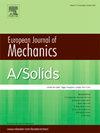Influence of heterogeneity on delamination of the solid-electrolyte interphase from silicon anode particles of lithium-ion batteries
IF 4.2
2区 工程技术
Q1 MECHANICS
引用次数: 0
Abstract
A finite deformation framework is employed to investigate the possibility of delamination of the solid electrolyte interphase (SEI) layer from a hollow cylindrical silicon (Si) anode particle during lithiation, accounting for SEI heterogeneity and mechanical deformation. The model includes a bilayer heterogeneous SEI with pre-existing cracks, situated on the outer surface of a fixed and axially constrained Si cylinder. Diffusion-induced stresses are investigated, together with plastic deformation of the active material and the SEI. Parametric studies are performed by varying SEI thickness, active material thickness, SEI heterogeneity, the mechanical and geometric properties of the organic and inorganic SEI layers, and the number of cracks. The results reveal that the presence of SEI heterogeneity raises the critical state of charge (SOC) required for delamination, thereby enhancing mechanical resilience. Plastic deformation delays the onset of failure by facilitating stress relaxation within the anode. A comparison between one-way and two-way coupling cases highlights the importance of feedback mechanisms in accurately capturing interfacial failure. The proposed modeling approach offers insights into improved design of artificial SEI layers that is expected to contribute toward the development of lithium-ion batteries.
非均质性对锂离子电池硅负极颗粒固-电解质界面分层的影响
采用有限变形框架研究了在锂化过程中固体电解质界面层(SEI)从空心圆柱形硅(Si)阳极颗粒剥离的可能性,考虑了SEI非均质性和机械变形。该模型包括一个具有预先存在裂纹的双层非均匀SEI,位于固定和轴向约束的Si圆柱体的外表面。研究了扩散引起的应力,以及活性材料和SEI的塑性变形。参数研究通过改变SEI厚度、活性物质厚度、SEI非均质性、有机和无机SEI层的力学和几何特性以及裂纹数量进行。结果表明,SEI非均质性的存在提高了分层所需的临界荷电状态(SOC),从而增强了机械弹性。塑性变形通过促进阳极内部的应力松弛来延缓失效的发生。单向和双向耦合情况的比较强调了反馈机制在准确捕获界面故障方面的重要性。所提出的建模方法为改进人工SEI层的设计提供了见解,有望为锂离子电池的发展做出贡献。
本文章由计算机程序翻译,如有差异,请以英文原文为准。
求助全文
约1分钟内获得全文
求助全文
来源期刊
CiteScore
7.00
自引率
7.30%
发文量
275
审稿时长
48 days
期刊介绍:
The European Journal of Mechanics endash; A/Solids continues to publish articles in English in all areas of Solid Mechanics from the physical and mathematical basis to materials engineering, technological applications and methods of modern computational mechanics, both pure and applied research.

 求助内容:
求助内容: 应助结果提醒方式:
应助结果提醒方式:


